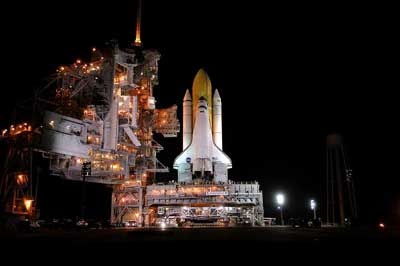Avi Blizovsky

Direct link to this page: https://www.hayadan.org.il/disocvery110405.html
The space shuttle Discovery, which is scheduled to depart in May for the International Space Station for the first time since the Columbia disaster, was therefore delayed for a short time after engineers found a crack in the insulating foam of the external fuel tank.
NASA stated that after a ten-hour transportation on a special truck, it was made clear that there was no danger to the shuttle.
NASA spokeswoman Jessica Rye said that photographs of the crack the width of a hair are now being examined by the manufacturers of the container. The spokeswoman said that NASA came to the conclusion that there was no need for repairs and continued to move Discovery from the assembly facility, therefore the launch, a distance of 6.4 km.
Following the Columbia disaster, the tank was redesigned for the Discovery flight. ""It doesn't sound like something serious, but because the foam is a sensitive issue we want to be sure that we are indeed in the permitted and safe area." Ray said.
Discovery's first launch window will be between May 15 and June 3 when the International Space Station is in the appropriate location. Everyone at the space agency, including the astronauts, understands that there are no shuttle missions without danger at all, but they believe that the only way to improve performance is to send it back into orbit.
"We are ready to go. I look forward to a new beginning," said NASA flight director Leroy Kane. "There are risks in this business, and our business is to manage those risks."
Changes in the fuel tank in preparation for the launch of STS114
Amir Brent
On February 1, 2003, the space shuttle "Columbia" crashed after seven launches, fragments of insulating foam broke off and damaged the cream panels that protect it during reentry into the atmosphere. After the crash, an investigative committee laid the blame on those insulation foam fragments but commented on many other failures, also on the administrative level. Since February 2003 no shuttle has been launched into space and in fact the US manned space program has taken a "time out". This time was used for re-evaluations for the launch of the space shuttle "Discovery" in the mission designated STS-114. The launch of STS 114 is scheduled to take place between May 14 and June 3, 2005.
Most of the media "fire" is drawn by those who are perceived to be guilty of the Columbia disaster, the insulation foam of the external fuel tank. The external fuel tank is the largest component of the space shuttle which includes the capsule, the fuel tank and two solid boosters. The fuel tank has to withstand the terrible pressures created during takeoff (more than 3 million kg of thrust) even though the thickness of its sides is only about 3 millimeters! Inside the fuel tank is housed not only the fuel but also the oxidizing agent, the combination of both of which creates the thrust the space shuttle needs to take off. The fuels and oxidizers are stored at very low temperatures and so that ice does not form because the fuel tank is covered with a layer of insulating foam.
The main innovations that were introduced to the ET 120 fuel tank (120external tank) include heated sleeves whose main purpose is to prevent ice from forming on the screws that connect the cover to the external fuel tank. Those screws, which are about 60 cm long and weigh about 30 kg, are blown up in a controlled manner about two minutes after the launch in ET 120. The screws will be caught in new containers. One of the most interesting changes is undoubtedly a number of cameras that will be installed on top of the fuel tank and will commemorate the launch. Apart from this, the thickness of the insulating foam in places prone to disconnection has been reduced.
These changes are the result of about two years of effort by NASA experts. All the improvements and changes have been tested "dry" but it remains to be seen that all the components will work smoothly and safely. The purpose of the STS 114 mission is to reach the International Space Station, bring a supply of food and air, but also additional equipment for the ongoing operation of the astronauts in Hatna, as well as additional experiments that will be flown in the Leonardo component.
For the (first) news in Universe Today
Ydan "Back to Space"
The space shuttle in Astropedia
https://www.hayadan.org.il/BuildaGate4/general2/data_card.php?Cat=~~~130741891~~~188&SiteName=hayadan
